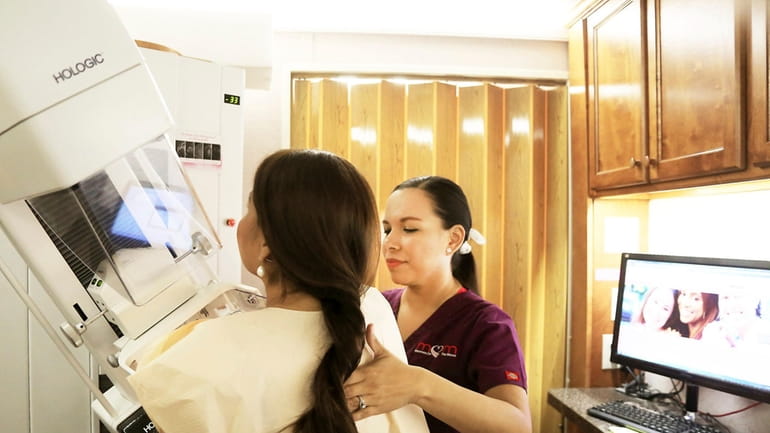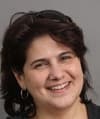Breast cancer screening barriers: CDC report reveals impact of social needs on mammograms

Routine mammograms can help detect breast cancer early and reduce breast cancer deaths by 22%, according to the CDC. Credit: AP/Miguel Roberts
Lack of transportation, income and access to food can make it more difficult for women to get lifesaving breast cancer screenings, according to a report from the Centers for Disease Control and Prevention released Tuesday.
About a third of women between the ages of 50 and 74 who dealt with those and other health-related social needs had not received a recommended mammogram during the previous two years, according to the national study based on 2022 data. Almost half of women between the ages of 40 and 49 had not received a mammogram during the previous two years.
Women were more likely to get mammograms in New York, where 78% of women between the ages of 50 and 74 and 66% between the ages of 40 and 49 who face these barriers had received a mammogram over the previous two years. The CDC defines health-related social needs as adverse social conditions that can negatively impact a person’s health or health care.
The Cancer Services Program of Suffolk County helps uninsured and underinsured people get access to certain cancer screenings, including mammograms.
“It’s always been very clear to me that the issue with low screening rates always ties to issues of poverty, where people are living and how they are living,” said director Maureen O’Connor, who is also a member of the American Cancer Society Advisory Board. “People are living paycheck to paycheck, worried about getting food on the table and the mortgage or rent.”
More than 40,000 women die from breast cancer each year in the United States, said Dr. Debra Houry, the CDC's chief medical officer, during a phone briefing with reporters Tuesday.
About 16,700 women are diagnosed with breast cancer every year in New York, state figures show. About 2,500 women die from the disease. Although it’s rare, men can also develop breast cancer.
State figures show that from 2016 to 2020, there were an average of 1,371 annual cases of female breast cancer in Suffolk County and 1,324 in Nassau County.
The U.S. Preventive Services Task Force, a national advisory group of experts, recommends that women between the ages of 50 and 74 at average risk get a mammogram every two years for breast cancer, while the decision to start screening at a younger age is “an individual one.”
“Routine screening mammograms can help detect breast cancer early when it is easier to treat,” Houry said. “It’s been shown to reduce breast cancer deaths by 22%.”
While cost is the biggest obstacle for most, others include being dissatisfied with life, feeling socially isolated and having reduced hours at work, according to the study.
Conversely, use of mammograms increases among people with better incomes and higher education, said Dr. Jacqueline Miller, medical director of the CDC’s National Breast and Cervical Cancer Early Detection Program.
“Women are more likely to get lifesaving mammograms when their social needs are met,” said Miller, lead author of the study.
Houry urged providers to conduct risk assessments for health-related social needs with their patients, refer them to local social services organizations for help and direct them to free and low-cost screenings.
Cancer Services Program of Suffolk County connects people with free screenings, transportation and food pantries.
“If we send someone somewhere, we know they are going to get what they need and it’s always going to be free,” O’Connor said.
Dr. Debbie Salas-Lopez, senior vice president of community and population health at New Hyde Park-based Northwell Health, said health care providers understand that factors outside of medical care have a large effect on a patient's health.
“Now we are screening for health-related social needs, identifying them and saying not only are these important, but we have to find ways to mitigate them and connect these women to the resources they need,” she said.
For example, women who work or take care of children at home may not be able to make mammography appointments during the day, when most centers are open.
Despite historical health disparities that have made them more at-risk for breast cancer mortality, the study showed Black women had the highest rate of getting mammograms every two years: 65.2% for ages 40-49 and 82.9% for ages 50 to 74. Miller said they have seen this trend in recent years but “can't say exactly why” in this study. She noted that the results of the survey are self reported.
The study examined responses from 117,466 women in the 2022 Behavioral Risk Factor Surveillance System, a phone survey administered by individual state health departments in conjunction with the CDC. Since this is the first time these questions were asked, the responses could not be compared with surveys from previous years.
Lack of transportation, income and access to food can make it more difficult for women to get lifesaving breast cancer screenings, according to a report from the Centers for Disease Control and Prevention released Tuesday.
About a third of women between the ages of 50 and 74 who dealt with those and other health-related social needs had not received a recommended mammogram during the previous two years, according to the national study based on 2022 data. Almost half of women between the ages of 40 and 49 had not received a mammogram during the previous two years.
Women were more likely to get mammograms in New York, where 78% of women between the ages of 50 and 74 and 66% between the ages of 40 and 49 who face these barriers had received a mammogram over the previous two years. The CDC defines health-related social needs as adverse social conditions that can negatively impact a person’s health or health care.
The Cancer Services Program of Suffolk County helps uninsured and underinsured people get access to certain cancer screenings, including mammograms.
WHAT TO KNOW
- Women who have lower incomes, unreliable transportation and housing instability are less likely to get mammograms every two years, according to a new report by the Centers for Disease Control and Prevention.
- Routine mammograms can detect cancers early and reduce breast cancer deaths by 22%, officials said.
- The CDC urged health care providers to conduct risk assessments for health-related social needs and connect them with resources.
“It’s always been very clear to me that the issue with low screening rates always ties to issues of poverty, where people are living and how they are living,” said director Maureen O’Connor, who is also a member of the American Cancer Society Advisory Board. “People are living paycheck to paycheck, worried about getting food on the table and the mortgage or rent.”
More than 40,000 women die from breast cancer each year in the United States, said Dr. Debra Houry, the CDC's chief medical officer, during a phone briefing with reporters Tuesday.
About 16,700 women are diagnosed with breast cancer every year in New York, state figures show. About 2,500 women die from the disease. Although it’s rare, men can also develop breast cancer.
State figures show that from 2016 to 2020, there were an average of 1,371 annual cases of female breast cancer in Suffolk County and 1,324 in Nassau County.
The U.S. Preventive Services Task Force, a national advisory group of experts, recommends that women between the ages of 50 and 74 at average risk get a mammogram every two years for breast cancer, while the decision to start screening at a younger age is “an individual one.”
“Routine screening mammograms can help detect breast cancer early when it is easier to treat,” Houry said. “It’s been shown to reduce breast cancer deaths by 22%.”
While cost is the biggest obstacle for most, others include being dissatisfied with life, feeling socially isolated and having reduced hours at work, according to the study.
Conversely, use of mammograms increases among people with better incomes and higher education, said Dr. Jacqueline Miller, medical director of the CDC’s National Breast and Cervical Cancer Early Detection Program.
“Women are more likely to get lifesaving mammograms when their social needs are met,” said Miller, lead author of the study.
Houry urged providers to conduct risk assessments for health-related social needs with their patients, refer them to local social services organizations for help and direct them to free and low-cost screenings.
Cancer Services Program of Suffolk County connects people with free screenings, transportation and food pantries.
“If we send someone somewhere, we know they are going to get what they need and it’s always going to be free,” O’Connor said.
Dr. Debbie Salas-Lopez, senior vice president of community and population health at New Hyde Park-based Northwell Health, said health care providers understand that factors outside of medical care have a large effect on a patient's health.
“Now we are screening for health-related social needs, identifying them and saying not only are these important, but we have to find ways to mitigate them and connect these women to the resources they need,” she said.
For example, women who work or take care of children at home may not be able to make mammography appointments during the day, when most centers are open.
Despite historical health disparities that have made them more at-risk for breast cancer mortality, the study showed Black women had the highest rate of getting mammograms every two years: 65.2% for ages 40-49 and 82.9% for ages 50 to 74. Miller said they have seen this trend in recent years but “can't say exactly why” in this study. She noted that the results of the survey are self reported.
The study examined responses from 117,466 women in the 2022 Behavioral Risk Factor Surveillance System, a phone survey administered by individual state health departments in conjunction with the CDC. Since this is the first time these questions were asked, the responses could not be compared with surveys from previous years.
Two body parts suspects in court ... Teen chicken keeper ... Rangers advance ... Penn upgrades
Two body parts suspects in court ... Teen chicken keeper ... Rangers advance ... Penn upgrades

